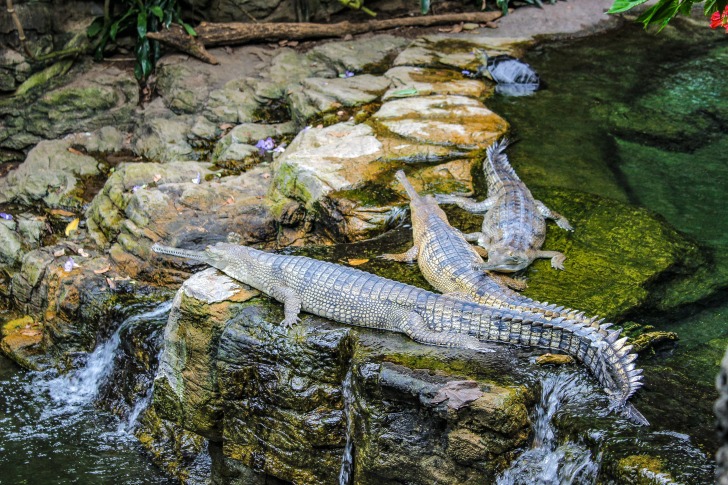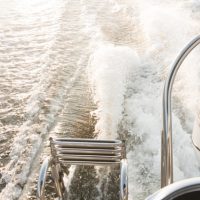Lake Travis is a popular body of water around Austin, Texas.
It is home to fishing, swimming, boating, and all sorts of other recreational activities.
How safe is the water, though?
If there are alligators calling the lake home, you should probably know before you decide to go for a swim.
Contents
So… Are There Alligators in Lake Travis?
Alligators look for freshwater lakes, rivers, swamps, and preserves to live in.
They are found throughout the southern part of the United States, which includes Texas, Louisiana, and Florida.
While most alligators are typically found closer to the northern part of the state, they will wander further south on occasion.
Lake Travis has been known to have a few alligators in it, though it is considered rare.
The lake is extremely large and is home to a significant amount of recreation, from boating to swimming to water skiing.
In peak season, there’s a lot of boat traffic – and this would be extremely off-putting to alligators.
Alligators like to keep to themselves.
They aren’t highly predatorial, but they do like to be left alone.
With so much activity on the lake, they would much rather call a swamp home where they won’t be bothered.
Essentially, there are alligators in Lake Travis, but the likelihood of them being spotted or attacking is extremely unlikely.

Alligator Species in Lake Travis
There are several crocodilians in the world, including alligators and crocodiles.
You won’t find crocodiles anywhere near Texas.
In fact, most are found only in South Florida and throughout parts of the Caribbean.
That leaves the alligator.
There are two species of alligators that exist in today’s world – the Chinese Alligator and the American Alligator.
Since the Chinese Alligator lives in China, that leaves the American alligator to contend with.
Its Latin name Alligator mississipiensis translates to Mississippi lizard.
However, it is found well beyond the Mississippi River.
The American alligator has been around the southern part of the U.S. for many years.
It typically includes Texas all the way to North Carolina for its habitat.
It prefers marshes and swamps but will use rivers and lakes when it is forced to do so.
It is a cold-blooded reptile, which means that it depends on heat.
It cannot thrive in areas where it gets too cold.
In fact, once it reaches a certain temperature outside, alligators stop eating and become extremely lethargic.
They’ll go into a form of hibernation and many won’t last past the winter.
As such, the only alligator species that you’ll find in Lake Travis is the American Alligator – and even then, it’s fairly rare that you’ll see one – especially if you stick to designated swimming and recreation areas.
Is It Safe to Swim in Lake Travis?
It is safe to swim in Lake Travis, though there are some things you should know.
There are quite a few parks around Lake Travis that offer swimming areas around the banks.
Many have buoys to show you where you can swim.
It’s advised that if you want to swim in the lake, you access it through one of the designated parks.
The lake has a large number of zebra mussels.
The shells can be extremely sharp, puncturing the skin.
When you’re in and around the water, it’s ideal to wear water shoes so you don’t risk cutting yourself.
There are also snakes in Lake Travis, but there aren’t any more than in any other lake in Texas.
Additionally, snake bites are rare.
Currents are rare unless there is flooding – and if that’s the case, most of the swimming areas would be closed.
As such, you’ll want to pay attention to reports of whether a park is closed or not.
Drowning happens at the lake every year.
Often, it is a result of unattended children, alcohol consumption, or unsafe swimming practices.
The state tests the water regularly to ensure it is safe. In some instances, cyanotoxins from blue-green algae have led to various dangers.
In the event that the water isn’t safe, there will be advisory postings on the park’s websites.
Interesting Alligator Facts in Lake Travis
Alligators are still relatively rare in the Lake Travis area, so whenever they show up, it ends up making the news.
There are only two fatal alligator deaths in the state’s recorded history.
One occurred in 1836 during a battle with the Mexican army.
The other is more recent, occurring in 2015 when a man wandered into a bayou in East Texas where an alligator known to be fed by humans attacked.
Some of the culverts in and around Lake Travis are filled with otters, fish, turtles, and crawfish.
This provides plenty of food for an apex predator like an American alligator.
As if that’s not enough, there have also been reports of dogs going missing, which says that the alligators will eat anything if it’s close enough to the body of water they call home.
The Texas Parks and Wildlife Department has been actively investigating the gator habitat and how it is growing in recent years.
There’s also a good reason why there are alligators in Lake Travis – and it’s not always as a result of migration.
In 1979, a story was published in The Daily Texan about a UT student who released over 300 baby alligators into Lake Travis and Lake Austin.
While some of the alligators would not survive, others would make it into adulthood and go on to breed with other alligators.
Other alligator sightings are often written off as a result of someone releasing a pet into the wild.
Most of the reports about an alligator being seen in a neighborhood or on the road near Lake Travis are written off as a hoax.
As such, most stay closer to the Trinity River of Fort Worth and throughout the Dallas-Fort Worth metroplex.
Across the state, it is estimated that approximately half a million alligators call Texas home.
If you want to learn more about alligators, it is possible to see them at the Discovery Center inside the Austin Zoo.
Alligators vs. Crocodiles
Alligators and crocodiles both fall into the family of Crocodilia.
While they both have scaly exteriors and walk on four legs, there are quite a few differences to help you tell them apart.
Alligators are black or gray with stumpy legs and rounded snouts.
With their jaws closed, you won’t see any of their teeth.
They also have webbed feet, making them excellent swimmers.
Crocodiles are green or brown with slightly longer legs and pointed snouts.
They have an overbite, and you can see some of their teeth when their mouths are closed.
They lack webbed feet but can still swim well.
Alligators typically won’t grow more than 12 feet long or weigh more than 800 pounds.
Adult males will be the larger of the breed.
Meanwhile, crocodiles can become enormous, with lengths of 20 feet long and weighing around 2,000 pounds.
The territory is a big determining factor, too.
Alligators like freshwater, though they can also tolerate brackish water.
They don’t have salt-excreting glands like crocodiles, so they can’t deal with water with high salinity levels.
Crocodiles thrive in saltwater.

3 Safety Tips for Swimming in Alligator-Infested Waters
It’s important that you follow safety tips any time that you go into water that is supposedly alligator infested.
Ideally, you shouldn’t go into the water at all if there is a large population of alligators around.
However, if you must, there are some ways that you can keep yourself safe.
Don’t Enter the Water at Night
Alligators may not have great night vision, but they can sense vibrations.
They are quite nocturnal, so any splashing that you do can lead them to believe that you are prey.
It’s best to go into the water between dawn and dusk.
This allows you to see them and for them to see you.
Avoid Going into the Water Alone
It’s never a good idea to go into the water alone, but this is especially true when there are alligators.
Make sure that someone else is around so that they can call for help if there’s trouble.
Keep Away from Tall Grass
Tall grass along the shoreline is often where alligators lounge.
It is also where they lay their eggs during the breeding season.
You don’t want a female alligator to assume that you mean it harm, so it’s best to enter where you have a clear line between ground and water.
Summary
Alligators are going to be found anywhere warm with fresh water.
Whether it is part of their natural habitat or they were placed there by someone who no longer wanted a pet, it is possible for alligators to thrive.
Lake Travis is both warm and freshwater, which means that alligators can and will be found within the lake.
Considering that it is a highly active lake, however, they are not found there very often.
Alligators prefer to be in areas where they are much less likely to be disturbed, such as some of the lakes and swamps within the northeastern part of the state.
Alligators aren’t known for viciously attacking unless they have been hand-fed by humans or they fear they are being attacked.
What this means is that if you do happen to come across an alligator in Lake Travis or anywhere else, give it some space so that you don’t have anything to worry about.
With so many parks and recreation areas around Lake Travis, you can typically enter the water with confidence as long as you follow all of the rules and warnings.
Frequently Asked Questions
No.
There are only approximately 10 alligator-related deaths reported in the US every year, and most of those take place in Florida.
Is it legal to have a pet alligator in Texas?
It is not legal to possess a live alligator in Texas unless you have an alligator farmer permit, which is obtained from the Texas Parks and Wildlife Department.
What are the most alligator-infested lakes in Texas?
While alligators are commonly found in Texas, most of the lakes that are considered alligator-infested are several hundred miles north of Lake Austin.
Lakes with more alligators include Lake Worth, Eagle Mountain Lake, and Lake Louisville.
Is it possible to outrun an alligator?
Yes, but it depends on where you are in relation to the alligator.
If you’re close to the shoreline and they dart out of the water, they can be extremely fast.
They lack endurance, which is what will typically allow you to outrun them.











